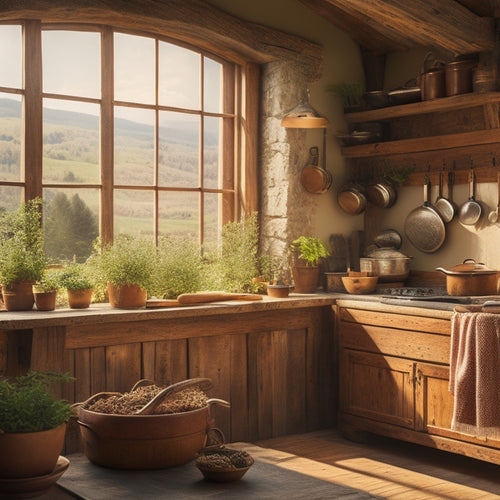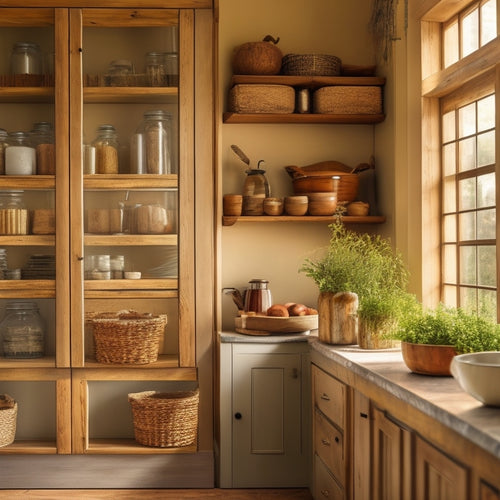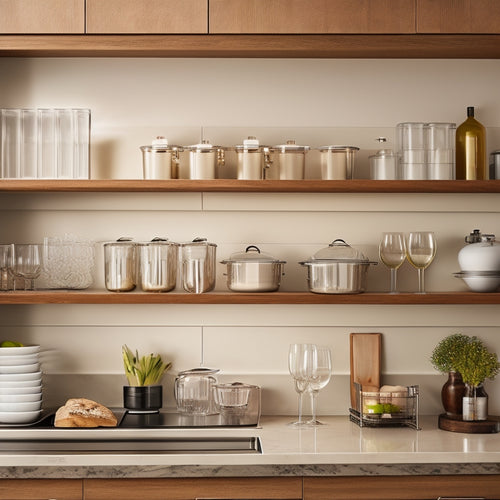
What's Holding You Back From a Clutter-Free Kitchen?
Share
You're frustrated with your cluttered kitchen, where every surface is crowded and meal prep feels like an obstacle course. But what's holding you back from achieving your dream kitchen? Is it the lack of a well-designed storage system, poorly utilized cabinet space, or disorganized countertops? Maybe it's the inadequate pantry shelving, insufficient drawer organization, or unutilized backsplash storage potential. Or perhaps it's the limitations of your kitchen island, insufficient hanging pot racks, or ineffective lid and accessory storage. Identify the bottlenecks and get ready to uncover the solutions that will transform your kitchen into a clutter-free haven, where cooking and sharing meals with loved ones becomes a joy.
Key Takeaways
• Inadequate storage systems and poorly utilized cabinet space hinder a clutter-free kitchen, leading to disorganization and inefficiency.
• Failure to categorize and prioritize items on countertops and in pantries results in clutter accumulation and wasted space.
• Inefficient use of vertical storage, corner spaces, and hidden areas, such as backsplashes and kitchen islands, contributes to clutter.
• Disorganization in drawers, lack of designated zones, and inadequate container selection hinder efficient storage and accessibility.
• Insufficient consideration of storage needs and ineffective solutions for specific items, like lids and accessories, exacerbate kitchen clutter.
Lack of Kitchen Storage Systems
Without a well-designed kitchen storage system, you're left scrambling to find a place for every utensil, gadget, and ingredient, leading to clutter and chaos. You're not alone in this struggle. Many homeowners face the same issue, but it doesn't have to be that way.
Custom solutions can be tailored to your specific needs, providing a sense of organization and calm in the heart of your home.
Modular units are a great way to achieve this. These versatile systems can be configured to fit your unique space and needs, ensuring that every item has a designated spot. Imagine being able to find what you need at a glance, without digging through drawers or cupboards.
With a well-designed storage system, you'll be able to focus on what matters most - cooking and sharing meals with loved ones.
Inefficient Use of Cabinet Space
When you take stock of your kitchen cabinets, you're likely to find that they're not being used to their full potential. You're probably leaving valuable space unused, making it harder to find what you need when you need it.
Max Out Shelves
You're likely wasting valuable cabinet space if you're not using stackable shelves or baskets to max out the vertical storage capacity of your cabinets. By installing shelves or baskets, you can increase storage capacity without sacrificing accessibility. This is especially important for frequently used items, like plates, bowls, and cups.
| Current State | Dream State | Actionable Tip |
|---|---|---|
| Cluttered shelves | Organized and labeled | Use shelf labels to categorize and prioritize items |
| Dead space above shelves | Maximized storage | Install stackable shelves or baskets |
| Hard-to-reach items | Easy access | Place frequently used items at eye-level or near the front |
When styling your shelves, consider grouping similar items together and reserving the top shelf for infrequently used items. By maximizing your cabinet space, you'll be able to find what you need quickly, reducing stress and increasing productivity in the kitchen.
Optimize Corner Areas
Corner areas in your cabinets are notorious for being difficult to access and often become a dead zone, wasting valuable storage space that could be better utilized.
It's easy to let clutter accumulate in these blind spots, making it challenging to find what you need when you need it. However, with a few simple tweaks, you can optimize these areas and make the most of your cabinet space.
Consider installing corner carousels or lazy susans that allow you to easily access items stored in these hard-to-reach areas. These clever solutions enable you to spin or slide out items, eliminating the need to dig through clutter or strain your back to reach them.
By utilizing corner carousels, you'll be able to store more items in less space, freeing up room for other essentials. Additionally, you'll reduce the likelihood of forgotten or expired items lingering in these blind spots.
Disorganized Countertop Clutter Zones
Your countertops are likely home to several clutter zones, including the appliance graveyard where dusty toasters and blenders go to die, and the messy magnet zone where notes, reminders, and coupons congregate in disarray. These clutter hotspots can lead to countertop chaos, making it difficult to cook, prepare meals, and even clean.
Take a closer look at your countertops and identify the areas that are causing the most clutter. Are there piles of mail, dirty dishes, or unnecessary appliances taking up valuable space?
To tackle these clutter zones, start by clearing everything off your countertops and sorting items into categories. Be ruthless – get rid of anything broken, outdated, or unnecessary. Once you've purged your countertops, assign a home for each item, and make sure it's easily accessible.
Consider investing in organizational tools like baskets, bins, or trays to keep items contained and out of sight. By streamlining your countertops, you'll create a more efficient and peaceful cooking environment that makes meal prep a breeze.
Poorly Designed Pantry Shelving
A poorly designed pantry shelving system can lead to a cluttered and chaotic storage space, making it difficult to find what you need when you need it. You're left digging through shelves, wasting time, and getting frustrated.
But, with a well-designed pantry shelving system, you can maximize your storage space and make meal prep a breeze.
Here are four common signs of poorly designed pantry shelving:
-
Fixed shelves: You're stuck with shelves that can't be adjusted to fit different sized items, leading to wasted space and clutter.
-
Inadequate storage: You don't have enough shelves or compartments to store all your kitchen essentials, forcing you to leave items out on the countertops.
-
Difficult access: You have to dig deep into the back of the pantry to find what you need, making it a hassle to cook or bake.
- Cluttered corners: You're left with awkward, hard-to-reach corners that collect dust and clutter, making it difficult to keep your pantry organized.
Consider investing in a pantry shelving system with adjustable heights and custom configurations to create a tailored storage space that meets your specific needs. With a well-designed pantry, you'll be able to find what you need quickly and easily, making cooking and meal prep a joy.
Inadequate Drawer Organization Tools
Now that you've tackled your pantry's shelving issues, it's time to turn your attention to your kitchen drawers. You're likely finding that without proper dividers, your utensils, cookware, and gadgets are jumbled together, making it difficult to find what you need when you need it.
To get your drawers in order, you'll need to address two key issues: the lack of drawer dividers and insufficient storage capacity.
Drawer Dividers Needed
Cluttered kitchen drawers often result from inadequate drawer organization tools, making it difficult to find what you need when you need it.
You're not alone if you've experienced the frustration of digging through a messy drawer to find a specific utensil or ingredient.
The good news is that implementing drawer dividers can make a significant difference in the functionality of your kitchen.
Here are some common scenarios that may sound familiar:
-
Kitchen utensils jumbled together, making it hard to find the one you need.
-
Food storage containers stacked haphazardly, increasing the risk of breakage.
-
Spices and oils scattered throughout the drawer, making it difficult to find what you need.
- Cookbooks and recipe cards cluttering up the space, making it hard to focus on meal prep.
Insufficient Storage Capacity
You've likely found yourself struggling to fit all your kitchen essentials into the available drawer space, leading to a frustrating game of Tetris every time you need to store or retrieve an item. This lack of storage capacity can lead to clutter and disorganization, making it difficult to maintain a clutter-free kitchen. To overcome this challenge, it's essential to focus on space planning and container selection.
| Space Planning Tips | Container Selection Guidelines |
|---|---|
| Measure your drawers accurately | Choose containers that fit perfectly |
| Identify frequently used items | Select containers with easy-open lids |
| Designate zones for specific items | Consider stackable containers for efficiency |
| Leave space for future additions | Label containers for easy identification |
| Consider a "junk drawer" for miscellaneous items | Use dividers for small items like utensils |
Unutilized Backsplash Storage Potential
By strategically incorporating storage solutions into your backsplash design, you can access a wealth of previously unused space, keeping essential kitchen tools and ingredients within easy reach. This often-overlooked area is prime real estate for maximizing your kitchen's storage potential.
Here are a few ways to reveal the hidden potential of your backsplash:
-
Decorative Niches: Create recessed areas to store frequently used items like oils, spices, or utensils, adding a touch of elegance to your kitchen design.
-
Hidden Compartments: Install sliding panels or secret drawers to stash away infrequently used items, keeping your countertops clutter-free.
-
Magnetic Strips: Add magnetic strips to store metal items like knives, spices, or hooks, freeing up valuable cabinet space.
- Tiered Shelves: Design multi-level shelves to store cookbooks, decorative items, or serving dishes, keeping them organized and within reach.
Kitchen Island Storage Limitations
Understanding these constraints is essential for maximizing the use of this valuable real estate in every kitchen island, no matter how spacious it may be. You need to acknowledge that your kitchen island's storage capacity is limited by its size and style. Island sizing plays a significant role in determining the amount of storage you can fit. A larger island can accommodate more cabinets, drawers, and shelves, while a smaller one may only have space for a few essentials.
Island style also affects storage options. For instance, a rustic or farmhouse-style island might've more open shelving, whereas a modern island might've sleek, closed cabinets.
To overcome these limitations, you should prioritize your storage needs. Identify the items you use most frequently and allocate space accordingly. Consider installing adjustable shelves, baskets, or dividers to optimize the use of available space. Additionally, think vertically by adding stackable storage or a pegboard to keep frequently used items within easy reach.
Insufficient Hanging Pot Racks
Inadequate hanging pot racks can severely hinder your kitchen's functionality, leaving you struggling to find a convenient place to store your cookware. This can lead to cluttered countertops, disorganized cabinets, and a generally chaotic cooking environment. To avoid this, consider the following:
-
Ceiling Clearance Considerations: Make sure you have enough clearance between your ceiling and the top of your cabinets to accommodate a hanging pot rack.
-
Pot Hanger Alternatives: If a traditional hanging rack won't fit, consider wall-mounted or foldable pot hangers as alternatives.
-
Assess Your Cookware: Take stock of your cookware collection and prioritize the items you use most frequently, reserving hanging space for those pieces.
- Measure Your Space: Measure your kitchen's dimensions to determine the maximum size of the hanging pot rack you can accommodate.
Ineffective Lid and Accessory Storage
Lid and accessory clutter can quickly spiral out of control, leaving you digging through chaotic cabinets and drawers to find the right fit for your pots and pans. This frustration can be a major obstacle to achieving a clutter-free kitchen.
To tackle this issue, consider investing in a Lid Organizer. This simple yet effective solution allows you to store lids in a compact, easy-to-access manner, freeing up valuable cabinet space.
For your kitchen accessories, such as utensils, gadgets, and spices, an Accessory Station can be a game-changer. This centralized hub keeps all your essentials within easy reach, streamlining food preparation and cooking.
Frequently Asked Questions
Can I Repurpose Old Furniture for Kitchen Storage Solutions?
You can breathe new life into old furniture by repurposing it as unique kitchen storage solutions. Consider a furniture revamp, adding decorative shelving to create functional and stylish spaces that serve your kitchen needs.
How Do I Keep My Kitchen Organized With a Large Family?
You'll maintain a clutter-free kitchen with a large family by implementing meal prep routines and designating snack stations, allowing everyone to grab-and-go while keeping countertops clear and organized.
Are There Any Affordable Kitchen Organization Systems Available?
Imagine a treasure chest overflowing with kitchen essentials, but instead, it's your kitchen, cluttered and chaotic. Fear not! You can access organized bliss with budget-friendly shelves and space savers, maximizing every inch without breaking the bank.
Can a Small Kitchen Still Have a Clutter-Free Design?
You can absolutely achieve a clutter-free design in a small kitchen by embracing space-savvy design principles, such as optimizing vertical storage, using multi-functional furniture, and selecting sleek, compact appliances that maximize functionality.
Do I Need to Hire a Professional for Kitchen Organization Help?
"When tackling kitchen organization, you're not alone - do you really need a pro's help? Consider your personal style and budget constraints; if you're willing to roll up your sleeves, DIY can be a cost-effective, empowering solution."
Related Posts
-

Rustic Hanging Racks for Country-Style Kitchens
Rustic hanging racks are a game changer for your country-style kitchen, blending functionality with charm. They maxim...
-

Freestanding Pantry Units for Farmhouse Kitchen Style
Freestanding pantry units perfectly blend beauty and function in your farmhouse kitchen. They maximize storage while ...
-

Pull-Out Cabinet Shelves for Dish Drainer Storage
Pull-out cabinet shelves are a revolutionary innovation for your dish drainer storage. They maximize vertical space a...


